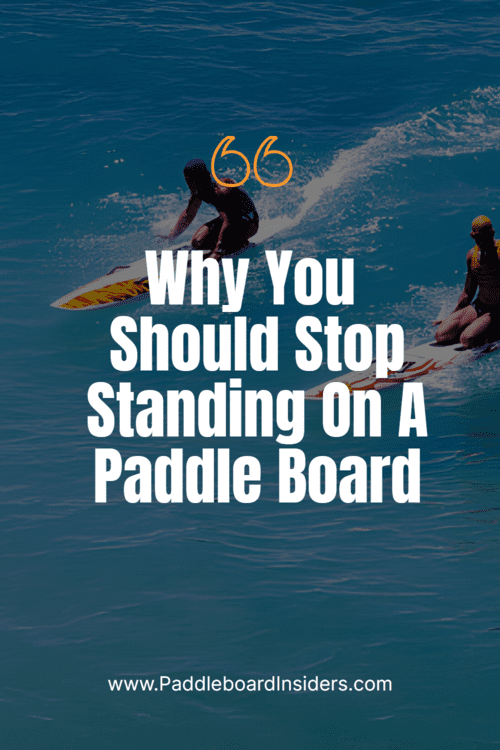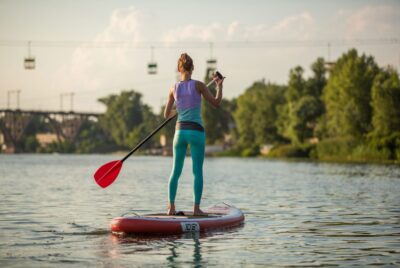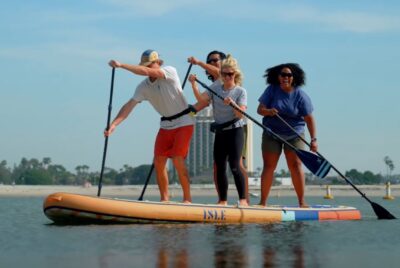Why You Should Stop Standing On A Paddle Board
*We may earn a commission for purchases made using our links. Please see our disclosure to learn more.
Many people struggle with balance while standing up, so why don’t you try using a knee paddle board?
This article gives tips on how to enjoy paddle boarding without always having to stand, and it’s also got some amazing health benefits that you can’t afford not to enjoy.
Keep reading for safer and more enjoyable ways to ride your board.
| Looking for our best paddle board product recommendations? Check the Paddleboard Insiders Buyer Guides |
Table Of Contents
- Benefits Of Using A Knee Paddle Board
- Best Beginner Knee Paddle Board To Buy In 2024
- How to Paddle Board on Your Knees
- When Not to Knee Paddle
- Conclusion:
- FAQs
- What are the risks of standing on a paddle board?
- Can I sit or kneel on a paddle board instead of standing?
- Is it necessary to stand up in order to enjoy paddle boarding?
- Are there any benefits to not standing on a paddle board?
- How does sitting or kneeling affect my experience with using a paddle board?
What is Prone Paddle Boarding?
Prone paddle boarding, often referred to simply as prone boarding, is a form of paddle boarding where the paddler lies face down on the board and propels a knee paddle board forward through the water using their arms. This contrasts with stand-up paddle boarding (SUP), where the paddler stands upright on the board and uses a paddle to move through the water.

In prone paddle boarding, paddlers use a swimming motion, similar to a front crawl, to move. The boards used for prone paddle boarding are usually long and narrow, designed for efficiency and speed in the water. This sport requires significant upper body strength, endurance, and technique, as it relies heavily on the arms, shoulders, and back muscles.
Benefits Of Using A Knee Paddle Board
Use a knee paddle board is awesome! This mode of paddle boarding can offer several benefits, both for recreational users and those seeking a different way to engage with water sports. Here are some of the key benefits:
| Lower Center of Gravity: | Kneeling on a paddle board lowers your center of gravity, which can make the board more stable and easier to balance on compared to standing. This is particularly beneficial for beginners or those who may feel less confident standing on a SUP. |
| Easier Learning Curve: | Because of the increased stability, beginners might find it easier to start with knee paddling before progressing to stand-up paddle boarding. The reduced risk of falling into the water can make the learning process more enjoyable and less intimidating. |
| Strengthens Different Muscle Groups: | While stand-up paddle boarding is known for providing a full-body workout, knee paddling emphasizes different muscle groups. It can be particularly engaging for the core and upper body muscles, including arms, shoulders, and back, as these are extensively used to maintain balance and propel the board. |
| Versatility in Activities: | Knee paddle boards can be used for a variety of water activities, including touring, fishing, and even yoga. The increased stability makes it easier to perform activities that require more balance, such as casting a fishing line or practicing yoga poses. |
| Good for Rehabilitation and Low-Impact Exercise: | For individuals with certain injuries or conditions that make standing for extended periods challenging, knee paddling offers a low-impact alternative that can be part of a rehabilitation program. It allows users to enjoy the benefits of paddle boarding without the strain that standing might impose on the lower body. |
Best Beginner Knee Paddle Board To Buy In 2024
So now that you know the benefits, let’s talk about a few great knee paddle board options that you can use to get started fast.
The Bluefin Sprint Carbon

Where To Buy: Amazon
Features & Specs:
- Complete set that includes everything you need to get started in prone paddleboarding
- Includes pumps, straps, bag and paddle (if you don’t want to prone paddle anymore)
- This is the BEST knee paddle board you can get without breaking the bank.
The Sprint Carbon revolutionizes knee paddle board design, pushing the boundaries of performance. This advanced board features revolutionary technologies, including carbon stiffening rails equipped with a Flex Reduction System (FRS) and the innovative AIR DUO dual inflation chamber technology. These enhancements make the Sprint Carbon the most rigid touring SUP in its category, offering a performance comparable to traditional hardboards. It’s a perfect match for both experienced paddlers and newcomers to the sport, providing exceptional stability and durability for anyone eager to venture into touring.
At the heart of the Sprint Carbon’s outstanding performance is its carbon fiber construction. The board is reinforced with carbon fiber rovings arranged in a diagonal twill pattern, culminating in a 3K carbon fiber rail layer. This design achieves a balance between stiffness and flexibility, all in a lightweight package. The carbon mid-rail’s heat-welded connection between the internal and external rail tapes further enhances the board’s tension and rigidity, ensuring unmatched strength.
A notable innovation in iSUP technology is the Independent Inflation Loop found in the Sprint Carbon. This unique feature operates separately from the board’s main air chamber, significantly enhancing durability, rigidity, and air capacity. Additionally, this design incorporates a crucial safety element, allowing the board to remain buoyant on the inflation loop alone. This guarantees that paddlers can enjoy their time on the water with the assurance that their board is designed to handle a variety of conditions safely.
| Check Price ➡️ Amazon |
Wowsea Swift S2
Where To Buy: Amazon
Features & Specs:
- High quality military grade PVC makes this extremely durable and stable.
- It’s designed to be a precision board that can cut through the water quickly.
- Its large 14′ dimension means it is perfect to kneel on it and paddle.

The SWIFT S2 inflatable stand-up paddleboard stands out for its exceptional durability, stability, and suitability for prone paddleboarding. Its meticulous design and construction cater specifically to those who prefer the prone paddling style. The board’s impressive dropstitch density of 11,200 per square meter, coupled with its double-layer, military-grade PVC rails, offers unparalleled rigidity and durability. This robust construction instills confidence as you glide through the waters.
Spanning 14 feet in length, 28 inches in width, and 6 inches in thickness, the SWIFT S2 achieves outstanding stability at a full inflation of 15 PSI, crucial for prone paddleboarding. Its generous dimensions create a stable and broad platform, enhancing balance and control, allowing for a comfortable and efficient paddling position.
A notable feature of the SWIFT S2 is its ability to perform exceptionally well at a lower air pressure, under 7 PSI, as indicated by the stationary dial pointer on the pump gauge. This characteristic ensures that the board maintains its stability and responsiveness, elevating the prone paddleboarding experience without compromising performance.
The SWIFT S2 is also furnished with a premium quality paddle and an innovative bolt lock fin system. The paddle, designed to disassemble into three parts easily, offers effortless storage and transport. This feature is particularly beneficial for prone paddleboarding, ensuring convenience when moving the board to and from the water.
| Check Price ➡️ Amazon |
Advanced Prone Paddle Boards
If you are someone that wants to get into prone paddle boarding seriously and enter some races, then there is no better place to get a board than Bark.
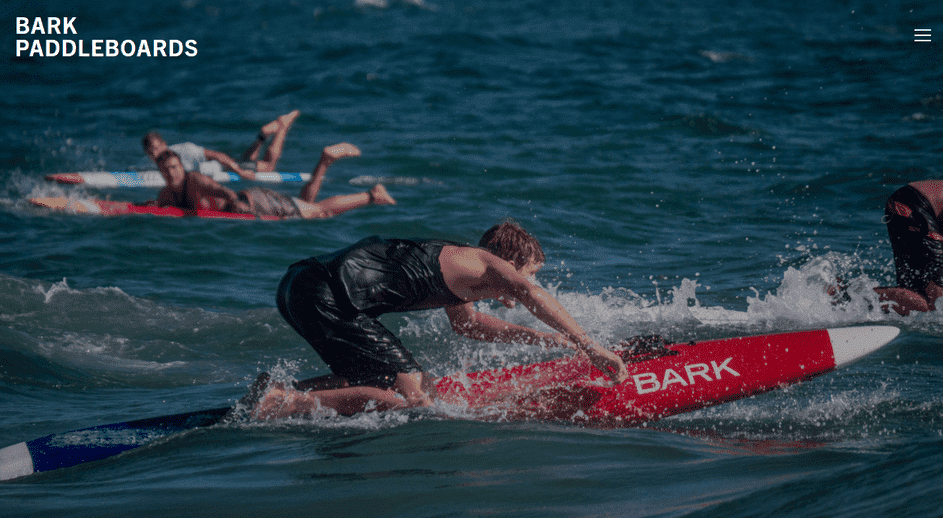
Bark Paddleboards, created by Joe Bark, stand out for their quality and design, making them a top choice in paddleboarding and surf sports. Joe Bark’s love for the ocean and expertise in board shaping have led to paddleboards that are not only high-performing but also built to last. These boards, known for their sleek and efficient shapes, are great for various paddling activities, including racing, touring, or just having fun on the water. They’re designed with a keen eye for detail, ensuring they perform well for everyone from competitive racers to casual paddlers. Bark Paddleboards are popular for their speed, stability, and smooth ride, appealing to both pros and everyday paddleboarders alike.
You can find our more information about them here.
| Looking for different paddle boards? The 8 Best Inflatable Paddle Boards Of 2024 Reviewed |
How to Paddle Board on Your Knees
To paddle board on your knees, start by getting into the kneeling position with your feet flat on the board and your hips resting back. Hold the paddle with both hands shoulder-width apart and adjust its length for better leverage when paddling from a kneeling position
Getting into knee paddling position
Knee paddling involves starting on your knees. Begin by kneeling at the center of your board with one knee in front and the other behind, keeping your body centered. Ensure a proper grip on the paddle to maintain control while maneuvering through water.
Adjust the paddle’s length for optimal leverage and reach, helping you propel forward with ease.
When transitioning from standing to kneeling becomes necessary due to changing conditions or surfing waves, mastering this technique will enhance stability and safety during unexpected situations.
Proper grip on the paddle (if you decide to use one)
You don’t need to use a paddle – but if you do, then hold the paddle with both hands, placing one hand on the top and the other about shoulder-width down. Keep your arms straight while paddling, using your core strength to pull through the water for maximum efficiency.
This grip allows you to maintain control and power as you navigate through different water conditions.
Once you have a proper grip on the paddle, it’s time to focus on getting into a comfortable kneeling position for paddle boarding.
Adjusting paddle length for best leverage
Having a proper grip on the paddle is essential, and so is adjusting the paddle length for optimal leverage. The right paddle length allows you to effectively propel yourself through the water while minimizing strain on your arms and shoulders.

To find the best length, stand the paddle next to you with the handle resting on the ground. Your wrist should bend slightly over the top of the handle when you reach up.
When paddling in calm waters or engaging in leisurely activities, a longer paddle provides better leverage. However, if you are expecting rough conditions or planning to surf small waves, a shorter paddle will give greater control and maneuverability.
When is the best time to paddle from your knees?
Knee paddling is an excellent option when you want more control in choppy conditions or when navigating through crowded areas and small waves. It’s also ideal for conserving energy during long paddles, especially in windy conditions.
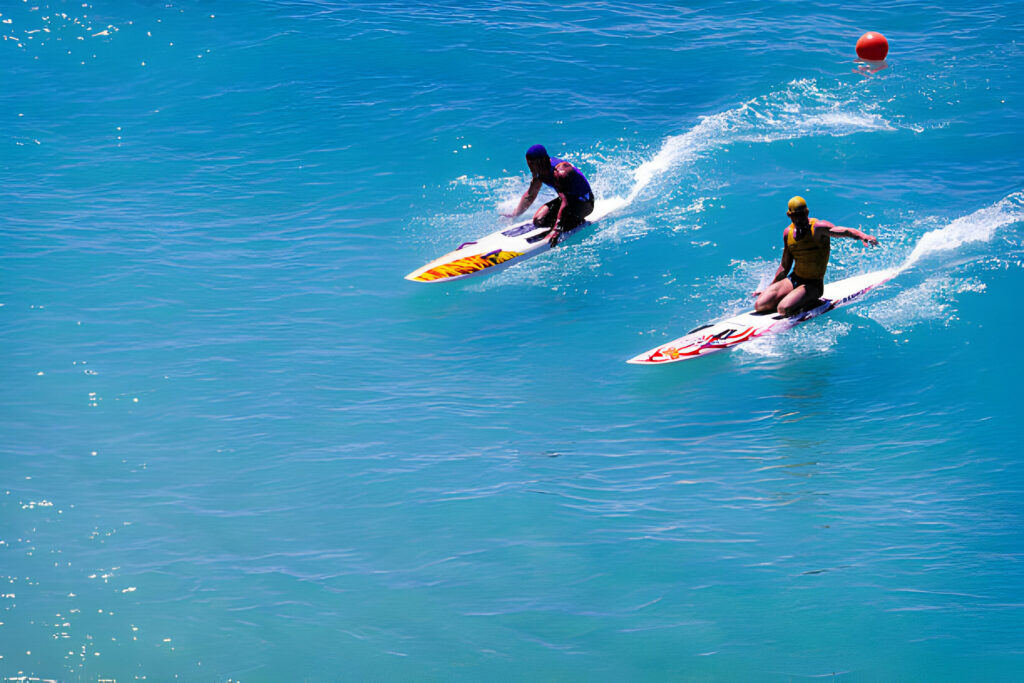
By staying closer to the board’s center of gravity, knee paddling allows for better stability and balance, enabling you to maintain control with ease.
In instances of high winds or crowded waters, paddle boarding from your knees offers added stability and maneuverability. When dealing with unpredictable changes in currents or wind gusts, knee paddling can help you stay balanced and avoid falling off the board.
When Not to Knee Paddle
Avoid knee paddling in unexpected changes in conditions or big waves. Shallow waters, high winds, and SUP surfing are also situations when knee paddling is not recommended.
Unexpected changes in conditions or big waves
Big waves and unexpected changes in water conditions can pose a significant challenge, especially for beginners. When encountering big waves, it’s crucial to stay low on your paddle board to maintain balance and stability.
Maintain a strong grip on the paddle and use it as support when navigating through turbulent waters. It is vital to anticipate sudden shifts in current or wind direction and adjust your paddling technique accordingly, ensuring that you don’t lose control of the board.
Additionally, staying alert and adaptable is key to safely maneuvering through unpredictable conditions while knee paddling.
In the face of changing conditions or large waves, adopting a knee paddling stance provides greater control over the paddle board. By utilizing this lower position, individuals can effectively navigate their way through challenging circumstances with enhanced stability and reduced risk of falling off.
Shallow waters
Navigating shallow waters on a paddle board requires caution and skill to avoid running aground or damaging the board. By keeping a close eye on water depth, paddlers can identify potential hazards such as rocks, sandbars, or coral reefs that might damage the board’s fin or hull.
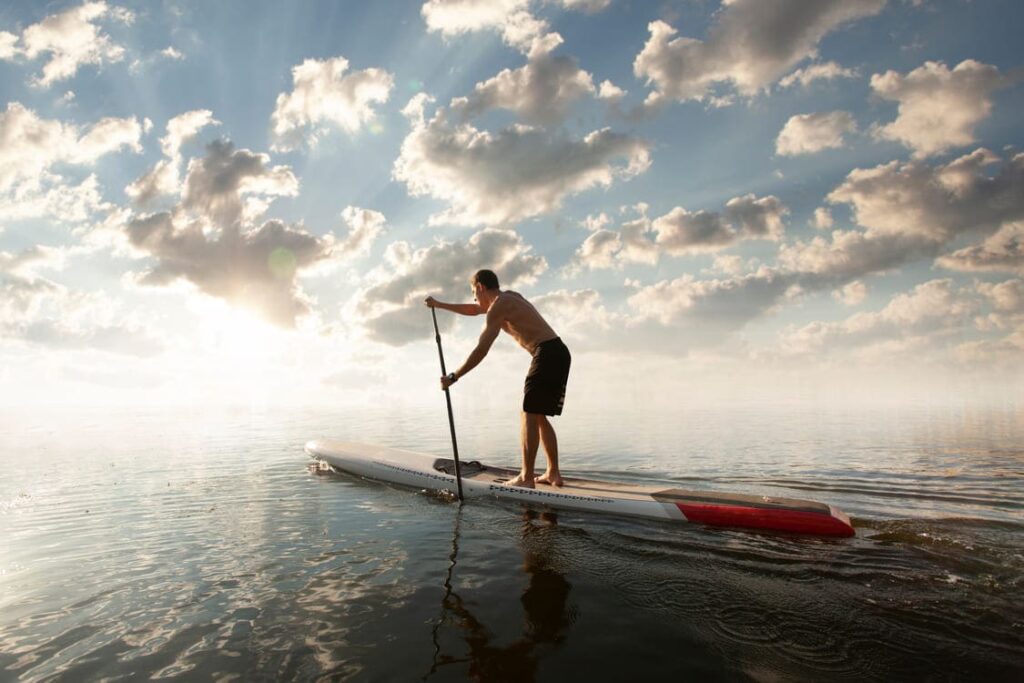
Proper technique is crucial in shallow areas, including maintaining an upright posture and lifting the paddle out of the water quickly to prevent hitting obstacles below the surface.
Carefully maneuvering through shallow waters also helps protect delicate marine ecosystems from unintentional damage caused by dragging a paddle across fragile corals or disturbing aquatic plant life.
High winds
Paddling in high winds can be challenging and potentially dangerous. Strong gusts can make it difficult to maintain balance on the board, increasing the risk of falling off and getting into trouble.
It’s important to pay attention to wind conditions before heading out, and if winds are too strong, consider postponing your paddle boarding adventure for another day. Keeping an eye on weather forecasts and being cautious when windy conditions arise is essential for a safe and enjoyable paddle boarding experience.
SUP surfing and knee paddling
Knee paddling is also a crucial skill for SUP surfing. It allows better maneuvering in the surf, especially when catching waves and controlling speed. When knee paddling during SUP surfing, you can maintain lower center of gravity and improved balance, ensuring a more stable ride on the waves.
This technique enables quicker turns and positioning adjustments, enhancing your overall performance in SUP surfing.
Conclusion:
Embarking on the journey of paddle boarding doesn’t always mean you need to stand up to enjoy the ride. Prone and knee paddle boarding offer unique advantages that cater to beginners, those looking for a stable and enjoyable experience, and even seasoned paddlers seeking new challenges. With the right board, like the Sprint Carbon or the SWIFT S2, you can explore the waters with confidence, enjoying the blend of stability, control, and versatility these styles offer. Whether you’re navigating choppy waters, conserving energy on a long journey, or just looking for a low-impact way to enjoy the water, prone and knee paddle boarding open up a world of possibilities. Remember, the key to a great paddle boarding experience lies in finding the right balance that suits your style, conditions, and personal preferences. So, grab your board, hit the water, and discover the joy of paddle boarding beyond standing up.
| Looking for insider guides to some amazing paddle boarding locations? Check the Paddleboard Insiders Location Guides |
FAQs
What are the risks of standing on a paddle board?
Standing on a paddle board can increase the risk of falling, losing balance, and potential injury.
Can I sit or kneel on a paddle board instead of standing?
Yes, sitting or kneeling on a paddle board provides stability and reduces the risk of falling while still allowing you to enjoy paddling.
Is it necessary to stand up in order to enjoy paddle boarding?
No, you can fully enjoy paddle boarding by sitting or kneeling while paddling without needing to stand up.
Are there any benefits to not standing on a paddle board?
Sitting or kneeling on a paddle board offers improved stability, reduced risk of falls, and is suitable for individuals with varying levels of balance and experience.
How does sitting or kneeling affect my experience with using a paddle board?
Sitting or kneeling provides increased comfort and control over the board’s movements, making it easier to navigate different water conditions while enjoying the scenery.
